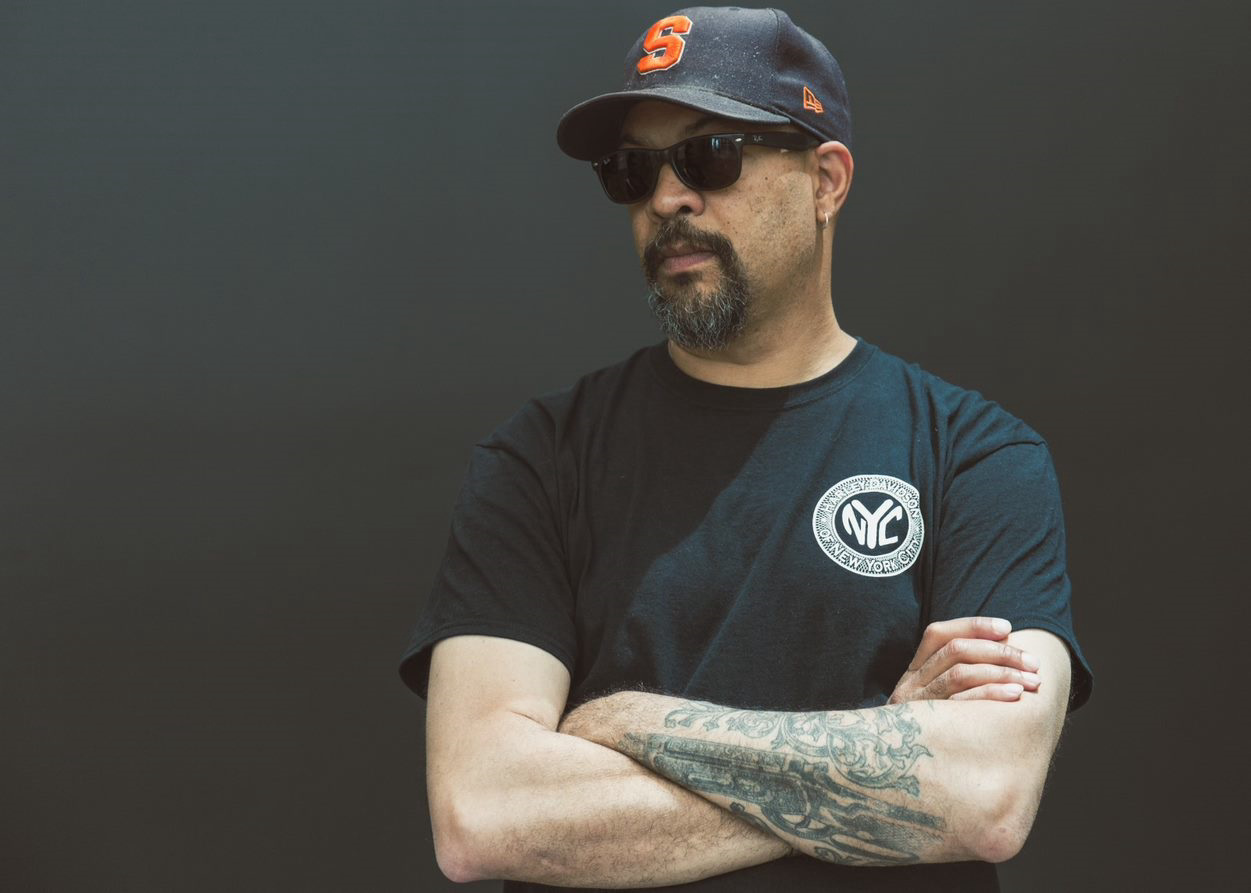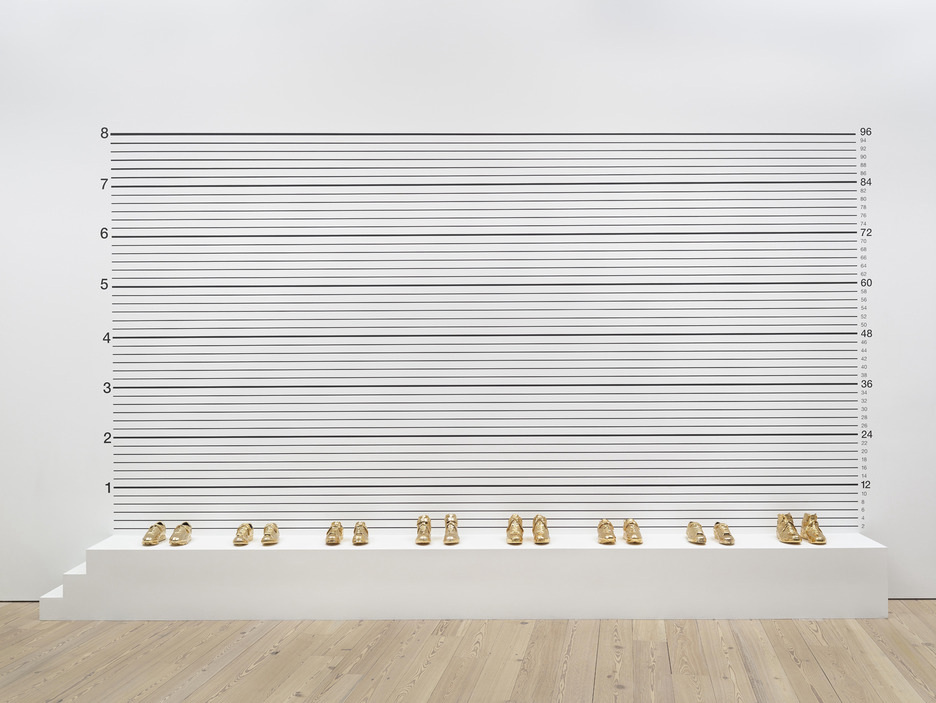Gary Simmons made his name by writing it in chalk. Since the late 1980s, the artist has been exploring the medium’s expressive potential, smearing and blurring images to leave the audience with traces of racist cartoon characters and other iconography linked to America's dark history. Caught in these white, wispy webs—which, like their references, can never be fully erased—are questions about race, power, and the fragility of memory. The New York-born and LA-based artist frequently employs and subverts motifs of American life, whether painting of the Hollywood sign set ablaze, constructing a sculpture of gold-plated basketball shoes in a police lineup, or building a gate flanked by twin sculptures of Klan members. Simmons has pushed museums to engage in direct conversations about race decades before the uprisings of 2020. Now, on the occasion of "Public Enemy," his first comprehensive career survey at the Museum of Modern Art Chicago, CULTURED spoke to him about what has changed over the past five decades—and what hasn’t.

CULTURED: How did you and the show's curator, René Morales, go about narrowing down your expansive body of work for this exhibition?
Gary Simmons: I tend to rely on the curator a lot for their vision. Most really good curators, René included, have a vision of how to present the work. A lot of times an artist can see through a kind of myopic lens and only see their work a certain way. But you have to open up and allow for other people's read. Folks that you trust can shape your work in a historic way.
CULTURED: Looking at what René picked out, was it interesting to see how your work evolved? Were there points where you could see the start of a direction you eventually took?
Simmons: It can be a little weird seeing work that will always be a part of you. You remember where you were, what you were doing, how you were living, who you were romantically connected to. Thirty-plus years have gone by. It's almost like seeing your kids off to college and then they go on to their own lives and their own careers. Then they come back for holiday dinners and you're like, “Wow, this is a very familiar person, but they're an adult and they're on their own. They've lived lives and they have relationships.” Especially with the older work, you're like, “Oh, there you are. You've aged well. You've lived a good life.” I imagine for some artists it can be difficult to navigate. For me, it almost acts as a motivational period where I feel like there's so much more that I have to say and do. It doesn't end here. I guess that's the difference between a survey and a retrospective.

CULTURED: The conversation about race in America has shifted a lot in the past couple of years. Have you seen a different reaction to your work over the course of your career? Has anything changed even from the time that you started planning this exhibition, before the pandemic, to now?
Simmons: I started out with such a political bent … that was controversial in some ways. It had that kind of youthful energy: loud, in your face. Speed forward 30-plus years later, and a lot of those same issues are just as relevant today as they were back then, which is disappointing.
Certain things have changed and allowed for a broader public to see some of the things that folks were raising issues about 30 to 35 years ago. We didn't have the luxury of social media to put it on blast and hold a mirror up. George Floyd, Breonna Taylor—it’s going on and we have it on tape.
There was a strong voice of protest when I first started making work. Looking at a moment when ACT UP was responding to the AIDS epidemic and it wasn't just isolated to gay folks. It was a very real, scary thing for everybody. The way the government was dealing with that was tragic and horrific. Race issues were going on then, 25 years before that, and 25 years before that. It's a consistent, ongoing nightmare that we have to deal with. Looking at some of the work, I'm like, Wow, this work still holds up. It still represents those voices. Interestingly enough, a lot of the work has a life of its own on social media that I didn't consider when I made it early on. There's a younger, smarter generation of folks who have other tools at hand to put a lot of that stuff on blast. And I think that's good.

CULTURED: You often include pop culture motifs and iconography in your pieces. How are you leveraging those for your own purposes?
Simmons: I have a piece in the show called the Backdrop Project, 1993. It's essentially a self-portrait that I don't exist in—almost like this composite of all the people and things that shape who and what I am. When that piece first started, it was using a lot of popular cultural references. There was a lot of Afrocentrism in there mixed with questions of police brutality and certain hip hop songs that were popular back then, like “Ill Street Blues” and The Chronic.
The way that piece addressed portrait and self-portrait, and the way that you project an image out to the world, has shifted and changed with the introduction of Instagram, where people take selfies, have other people take portraits of them and their friends.
They curate their own Instagram feed, although I think that's a poor use of the word "curate.” Just because you're selecting certain pictures doesn't make you a curator. It's interesting how certain phrases get redefined, like "woke.” It's funny to me how that has been co-opted by the right to describe folks on the left. And the original definition of "woke" has been totally distorted. It's like when you hear your grandparents start using slang terms.
Anyway, there's always this consistent interest in shaping the way that the world sees you. That piece, at its base, is really about how we not only see ourselves but want ourselves to be viewed by the world around us.

CULTURED: Could you discuss the role of nostalgia in your work? It’s obviously very evocative, but you also portray it as somewhat dangerous.
Simmons: Work that teeters on the razor's edge of nostalgia can be dangerous because it can tip into a saccharine translation of the period. What I'm most interested in is the way we reform memories as they fade. We have to fill in those gaps. That's at the core of what the work is about: that space between abstraction and representation. When you're looking at a drawing or a painting of mine, and part of it is blurred, smudged, or erased, the viewer is called upon to fill in gaps according to their own histories and memories. That's where the work has access points that aren't just through one lens.
This was a lesson I learned early on when I started to travel and realized that some of the work wasn't received in the same way I had put it together. The responsibility for that lies on me, not on the work. I can't force a certain interpretation. Once you start leaning into one way of thinking, it gets dogmatic. That's where the nostalgia comes in. If it gets too heavy-handed, then it falls under the umbrella of nostalgia—that sweet, cloying reconstruction of the past. Or does it tilt back the other way, allowing people to raise questions about their upbringing, their class structure, and what these images or icons mean to them? That's the delicate razor’s edge you have to walk when dealing with work that hints at nostalgia.
"Public Enemy" will be on view from June 13 through October 1, 2023 at the Museum of Contemporary Art Chicago.










 in your life?
in your life?

